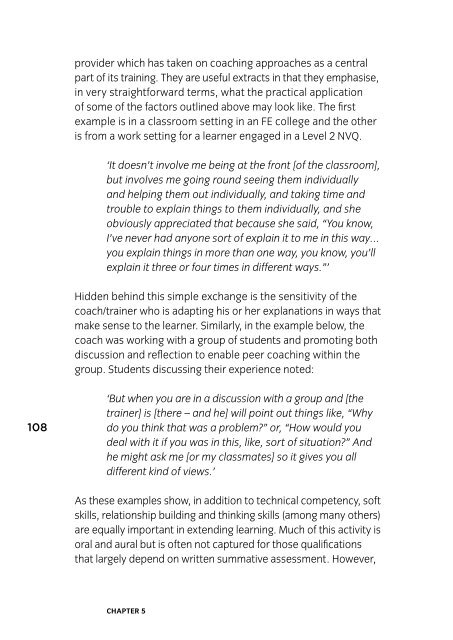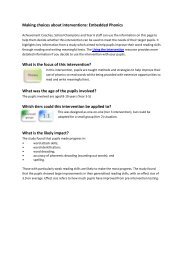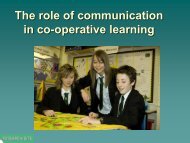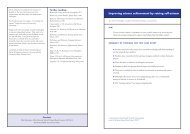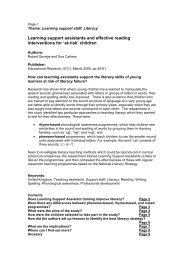the role of coachIng In vocatIonal educatIon and traInIng
the role of coachIng In vocatIonal educatIon and traInIng
the role of coachIng In vocatIonal educatIon and traInIng
You also want an ePaper? Increase the reach of your titles
YUMPU automatically turns print PDFs into web optimized ePapers that Google loves.
108<br />
provider which has taken on coaching approaches as a central<br />
part <strong>of</strong> its training. They are useful extracts in that <strong>the</strong>y emphasise,<br />
in very straightforward terms, what <strong>the</strong> practical application<br />
<strong>of</strong> some <strong>of</strong> <strong>the</strong> factors outlined above may look like. The first<br />
example is in a classroom setting in an FE college <strong>and</strong> <strong>the</strong> o<strong>the</strong>r<br />
is from a work setting for a learner engaged in a Level 2 NVQ.<br />
‘It doesn’t involve me being at <strong>the</strong> front [<strong>of</strong> <strong>the</strong> classroom],<br />
but involves me going round seeing <strong>the</strong>m individually<br />
<strong>and</strong> helping <strong>the</strong>m out individually, <strong>and</strong> taking time <strong>and</strong><br />
trouble to explain things to <strong>the</strong>m individually, <strong>and</strong> she<br />
obviously appreciated that because she said, “You know,<br />
I’ve never had anyone sort <strong>of</strong> explain it to me in this way…<br />
you explain things in more than one way, you know, you’ll<br />
explain it three or four times in different ways.”’<br />
Hidden behind this simple exchange is <strong>the</strong> sensitivity <strong>of</strong> <strong>the</strong><br />
coach/trainer who is adapting his or her explanations in ways that<br />
make sense to <strong>the</strong> learner. Similarly, in <strong>the</strong> example below, <strong>the</strong><br />
coach was working with a group <strong>of</strong> students <strong>and</strong> promoting both<br />
discussion <strong>and</strong> reflection to enable peer coaching within <strong>the</strong><br />
group. Students discussing <strong>the</strong>ir experience noted:<br />
‘But when you are in a discussion with a group <strong>and</strong> [<strong>the</strong><br />
trainer] is [<strong>the</strong>re – <strong>and</strong> he] will point out things like, “Why<br />
do you think that was a problem?” or, “How would you<br />
deal with it if you was in this, like, sort <strong>of</strong> situation?” And<br />
he might ask me [or my classmates] so it gives you all<br />
different kind <strong>of</strong> views.’<br />
As <strong>the</strong>se examples show, in addition to technical competency, s<strong>of</strong>t<br />
skills, relationship building <strong>and</strong> thinking skills (among many o<strong>the</strong>rs)<br />
are equally important in extending learning. Much <strong>of</strong> this activity is<br />
oral <strong>and</strong> aural but is <strong>of</strong>ten not captured for those qualifications<br />
that largely depend on written summative assessment. However,<br />
<strong>the</strong> workplace coach or assessor can capture <strong>the</strong> behavioural<br />
aspects <strong>of</strong> learning at work through what has come to be termed<br />
‘<strong>the</strong> pr<strong>of</strong>essional discussion’.<br />
The notion <strong>of</strong> <strong>the</strong> ‘pr<strong>of</strong>essional discussion’ is an<br />
assessment conversation based on <strong>the</strong> activities <strong>the</strong> learner has<br />
been engaged in. It involves an explanation by <strong>the</strong> learner,<br />
encouraged <strong>and</strong> assisted by <strong>the</strong> coach, <strong>of</strong> how work activities<br />
have demonstrated capability <strong>and</strong> what more <strong>the</strong> learner feels<br />
<strong>the</strong>y need to know or do. The ‘pr<strong>of</strong>essional discussion’ in<br />
vocational qualifications appeared first in <strong>the</strong> 1996 Customer<br />
Service St<strong>and</strong>ards <strong>and</strong> was described in <strong>the</strong> following way:<br />
‘A pr<strong>of</strong>essional discussion between assessor <strong>and</strong><br />
c<strong>and</strong>idate [implies] a recognition <strong>of</strong> <strong>the</strong> different skills,<br />
experience <strong>and</strong> underst<strong>and</strong>ing <strong>of</strong> customer service that<br />
each bring to <strong>the</strong> conversation.’ (Devereux, 1997, p. 7.)<br />
These iterative feedback loops which form a central part <strong>of</strong> <strong>the</strong><br />
process are integral to utilising coaching approaches as a<br />
formative assessment tool, as Sadler (1998: 84) emphasised:<br />
‘By quality <strong>of</strong> feedback, we now realise we have to<br />
underst<strong>and</strong> not just <strong>the</strong> technical structure <strong>of</strong> <strong>the</strong><br />
feedback (such as its accuracy, comprehensiveness <strong>and</strong><br />
appropriateness) but its accessibility to <strong>the</strong> learner<br />
(as a communication), its catalytic <strong>and</strong> coaching value<br />
<strong>and</strong> its ability to inspire confidence <strong>and</strong> hope.’<br />
This describes what <strong>the</strong> pr<strong>of</strong>essional discussion should be in<br />
terms <strong>of</strong> <strong>the</strong> feedback it <strong>of</strong>fers. It can be seen as a form <strong>of</strong><br />
coaching that integrates very closely with assessment for<br />
learning <strong>and</strong> is particularly appropriate for a large number <strong>of</strong><br />
vocational qualifications, opening up coaching opportunities in<br />
what increasingly become expansive − ra<strong>the</strong>r than restrictive<br />
− learning environments (Fuller & Unwin in Evans 2006, pp. 27 – 48).<br />
109<br />
CHAPTER 5<br />
The <strong>role</strong> <strong>of</strong> coaching in vocational education <strong>and</strong> training


